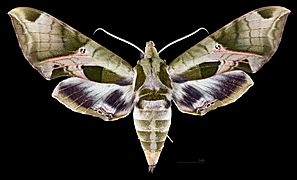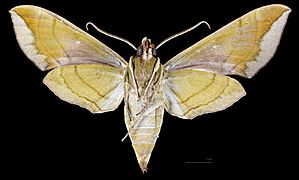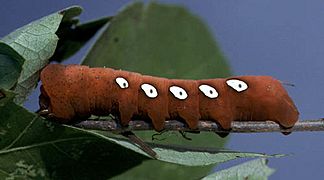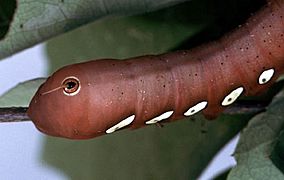Pandora sphinx moth facts for kids
Quick facts for kids Pandora sphinx moth |
|
|---|---|
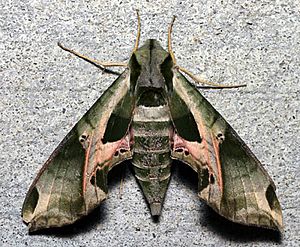 |
|
| Conservation status | |
|
Not evaluated (IUCN 3.1)
|
|
| Scientific classification | |
| Kingdom: | |
| Phylum: | |
| Class: | |
| Order: | |
| Family: | |
| Genus: |
Eumorpha
|
| Species: |
E. pandorus
|
| Binomial name | |
| Eumorpha pandorus (Hübner, 1821)
|
|
| Synonyms | |
|
|
The Pandora sphinx moth (scientific name: Eumorpha pandorus) is a large, beautiful moth found in North America. It belongs to a group of moths called Sphingidae, often known as sphinx moths or hawk moths. This amazing insect was first described by a scientist named Jacob Hübner in 1821.
Contents
What Does the Pandora Sphinx Moth Look Like?
This moth is quite large. It has a wingspan of about 3.25 to 4.5 inches (8.2 to 11.5 cm). Female moths are usually a bit bigger than males.
The Pandora sphinx moth is mostly greenish-gray. It has darker patches on its wings and pretty pink edges. You might also notice small pink spots that look like eyes, called eyespots. These can sometimes scare away predators. The underside of the moth is usually a pale yellow-green or brown color.
Pandora sphinx moths are active during the evening, around dusk. Depending on where they live, some areas might see one group of moths hatch each year. Other places might see two groups hatch.
-
An adult moth resting in Durham
Where Do Pandora Sphinx Moths Live?
You can find the Pandora sphinx moth across a large part of North America. They live in the eastern, southeastern, and central areas. Their range stretches from places like Nova Scotia and Ontario in Canada, all the way south to Florida and Texas in the United States.
Life Cycle of the Pandora Sphinx Moth
The Pandora sphinx moth goes through several stages in its life, just like many other insects.
Eggs and Caterpillars
Adult female moths lay their eggs one by one on the leaves of certain plants. These eggs are clear, almost see-through. The main plants they choose are grape vines (Vitis) and Virginia creeper (Parthenocissus). These plants are called "host plants" because they provide food for the young.
When the eggs hatch, tiny caterpillars (also called larvae) emerge. These caterpillars are quite large. They can be green or red. They have a special swollen part near their head. They can pull their head and first two body parts into this swollen area if they feel threatened.
The caterpillars also have some unique markings. They have a small white spot on their second body segment. They also have five large, oval white spots near their breathing holes, called spiracles. Young caterpillars have a "horn" at the end of their body. As they grow bigger, this horn changes into a small button-like bump.
These caterpillars are very hungry! They eat a lot of leaves.
Pupation and Emergence
Once a caterpillar has eaten enough and is ready to change, it climbs down from its host plant. It then burrows into the ground. This is where it will turn into a pupa. The pupa is dark brown and quite slender. It has a long, hook-like part called a cremaster.
The pupa stays underground for a few weeks or even a few months. This depends on the time of year and which generation of moths it is. When the pupa is ready to become an adult moth, it wiggles its way up to the surface of the ground.
Soon after, the adult moth emerges from the pupa. The newly hatched moth will climb onto a plant or another surface. It then pumps fluid into its wings to make them expand and become strong enough for flight.
Adult Moths
Once the adult moths are ready, they can fly and find a mate. Female moths release special scents called pheromones at night. These pheromones help male moths find them. The males fly into the wind, following the scent to locate the females.




